St Petersburg,
Russia
Story
written
by Rick Archer
February 2013
|
As this
fascinating overhead view of St. Petersburg makes clear,
this amazing city was built right on top of a
gigantic swamp.
The history of
Russia is so interesting that I previously wrote a five
chapter synopsis of Russian History.
To understand
the story behind the creation Saint Petersburg, I highly
recommend you read my two chapters on Peter the Great.
Chapter Two is a
biography of Peter the Great, the founder of this great
city.
Chapter Three
tells the story of the Great Northern War and the founding
of Saint Petersburg. Obviously I am biased, but the
history of Saint Petersburg is literally one of a kind.
One warning -
the history of Russia is so amazing you will take a great
risk if you read even ONE of the five chapters. You
could easily end up reading all five chapters. So be
careful!
|
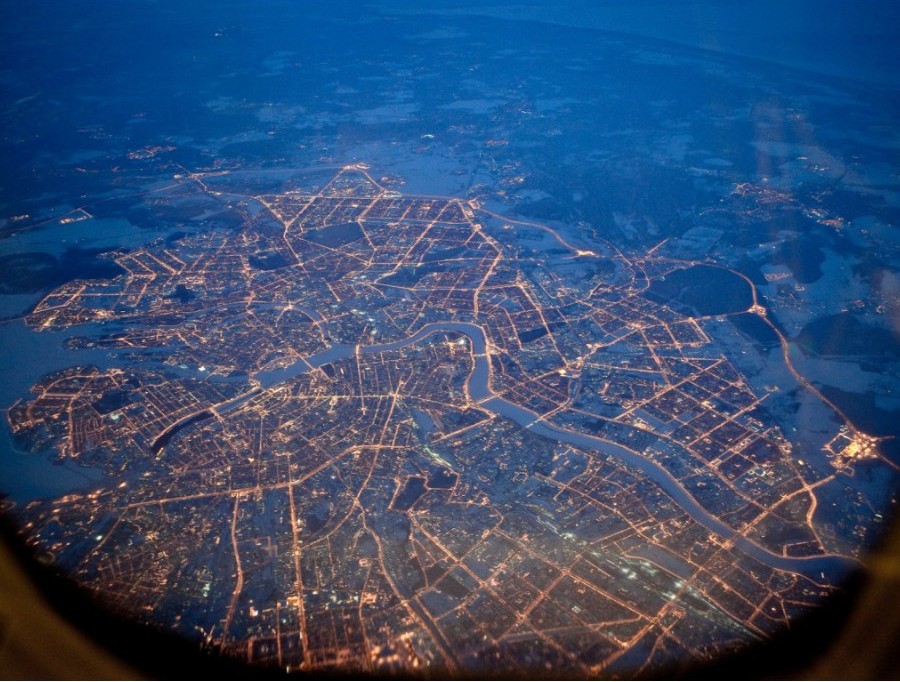 |
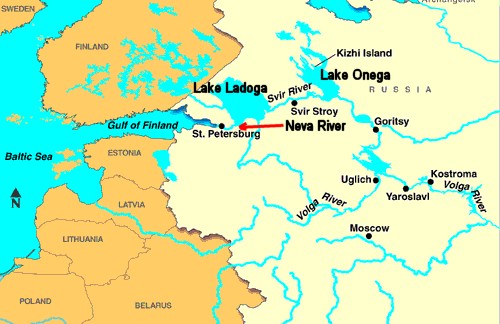 |
As the map
indicates, Saint Petersburg lies at the mouth of a massive
watershed. Lake Ladoga and Lake Onega respectively are
the first and second largest lakes in Europe. Both
lakes drain their considerable waters into the Gulf of Finland via the
Neva River.
When Peter the
Great first surveyed this area in 1700, this spot was
nothing more than a river delta consisting of hundreds of
small islands surrounded by water everywhere.
Nevertheless, this spot was the perfect place to build his
long-coveted
port to the West. He wanted to build a city, but first he needed a fortress. Russia
was a poor, backwards country at the time with a weak army
and no navy. It occurred to Peter that among the few resources Russia had at the time was lots of dirt and plenty
of serfs.
So Peter put the
serfs to work carrying massive amounts of Russian soil into
the area to create landfills. By connecting all the
various small islands together, slowly but surely four large
islands and several smaller islands took form. Finally
there was enough landmass to begin building on.
|
The Peter and
Paul Fortress went up in a hurry. Then construction of
the city began. Peter the Great had visited Amsterdam
and modeled his new city on the canals used by the Dutch.
The mighty Neva River was tamed by enclosing its banks in
high walls and giving it five different routes to reach the
sea.
St. Petersburg
was born in 1703. This date marks the start of
Russia's entry into world politics. It also began
three hundred years of expansion that would one day see
Russia rival the USA for position as the mightiest country
in the world.
Unfortunately,
in many ways, Russia has been its own worst enemy.
Many people point to its bitter subjugation for three
centuries under Mongol rule as the reason for a seeming
inherent cruelty in the Russian ethos. The evil
displayed by Stalin and his successors during the Soviet era
has been difficult to forget.
Thanks to
a remarkable leader known as Mikhail Gorbachev who ended the
Communist era in 1991, for the past 20 years, Russia has
been trying to climb out of its anti-social shell.
Quite frankly, Russia still has a ways to go.
Russia is not exactly the most tourist-friendly country in
the world. I had advance warning that Russia was still a bit
on the "cold side" if you know what I mean.
Unless Marla and
I each
purchased a very expensive $200 Russian visa well in advance
of our trip, we were not allowed on Russian soil on our own.
This gave us no other choice but to sign up for an excursion sponsored by the cruise ship.
Now if we had signed
up for a river tour in Russia or we were going to visit the
country for
any length of time, it would be worth the trouble and expense
to get a Russian visa. However for just a day trip, it was
easier to simply sign up for a ship excursion.
As it turned
out, the Russian tour guide would also serve as a supervisor
of sorts.
She would not only escort us around the city, she was
supposed to keep an eye on us.
Unfortunately,
Tatiana, our own tour guide, somehow lost count of us and spent the rest of
the day counting heads like crazy trying to figure out her
mistake. She had one more person than ticket. At one time on the bus, she begged us all to
check our pockets for a missing ticket.
At the time I wondered why she was so
nervous, but later I realized how much trouble she could be in
for letting someone sneak in. They definitely did NOT want
dangerous "undocumented" cruise ship passengers
like us wandering
through their city to steal State secrets and treasures.
After all, everyone knows the CIA loves to smuggle in its
spies using cruise trips. So efficient and so
pleasurable.
|
Now that I think
about it, there was evidence of lingering paranoia every
place I visited. As I left the
ship, I asked one of the ladies who was involved with
getting people to the right bus if I could take her picture. The woman turned
pale as a ghost and said, "WHY??" in a frightened voice. She covered her face as if I was a monster and immediately
half-walked, half-ran away.
I have never had
that happen before. There is obviously a lingering
fear that still pervades this country.
In the morning
Marla and I visited Peterhof, Peter the Great's amazing
estate. Peterhof is located 25 miles away outside of
town. It took us nearly an hour both ways by bus to
get there.
In the afternoon
we visited the Hermitage, Catherine the Great's famous art
museum. The Hermitage is located along the banks of
the Neva River across the river from Peter and Paul Fortress.
A Red X
marks the spots for Peterhof and the Hermitage.
|
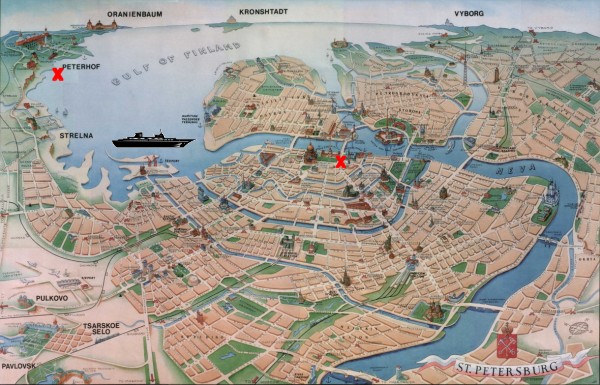 |
Before I begin the
story of our visits, I would like to remind everyone that
Marla wrote an extensive Travel article on the highlights of
St. Petersburg complete with pictures. If you would
like to read the details of her research, please visit
Marla's Description of Saint Petersburg.
Now let's start
with some pictures of
the famous landmarks of Saint Petersburg.
|
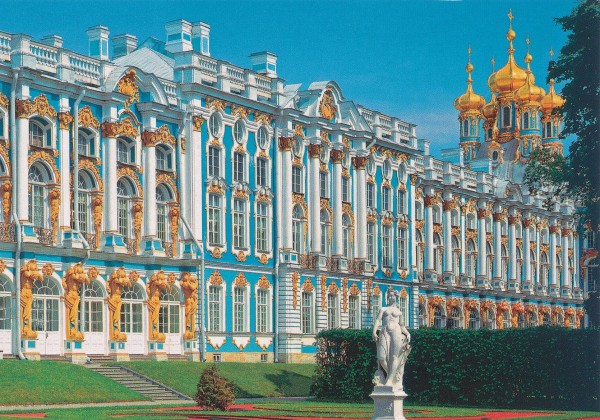
South
front of Catherine's Winter Palace |
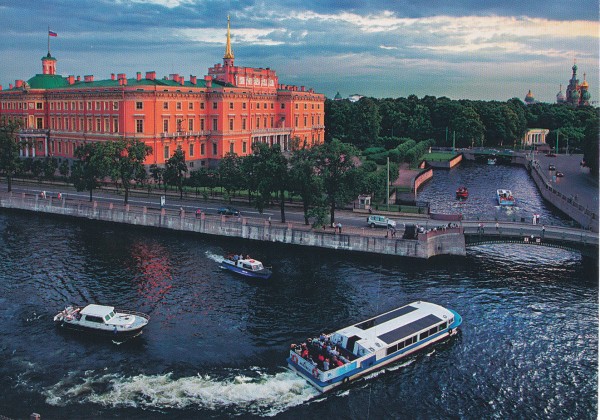
Mikhailovsky Castle |
| |
|
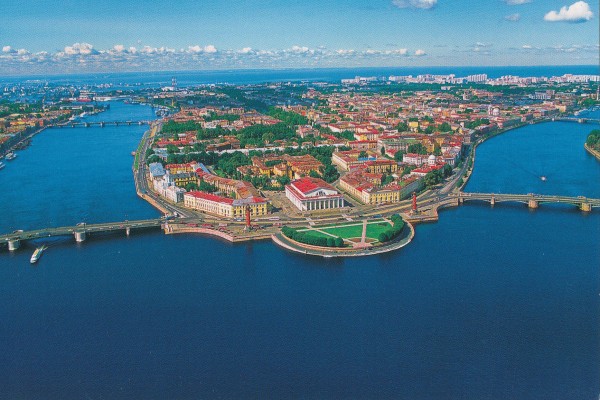
Vasilevsky
Island, the Neva River, and Neva Bay in the background |
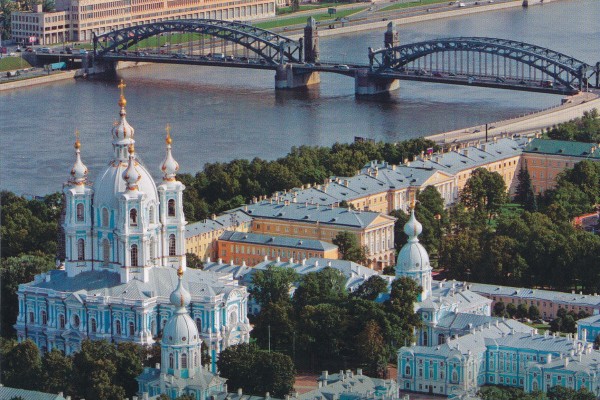
Smolny
Cathedral |
| |
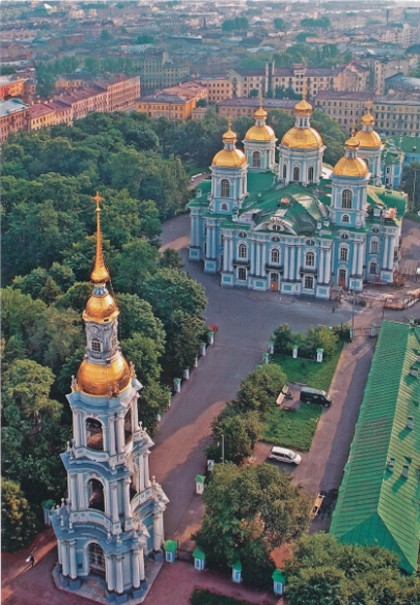
St Nicholas
Cathedral |
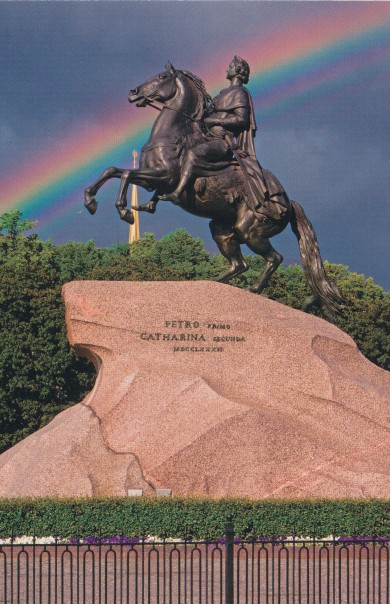
Monument to Peter
the Great |
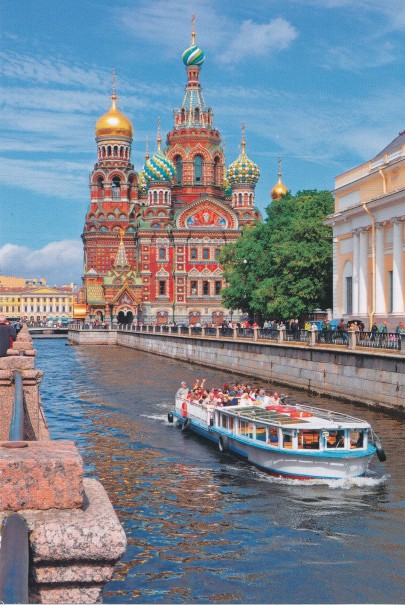
Cathedral of the
Resurrection |
|
| |
|
Russia had a leader
named Alexander II whose life had some strange parallels to our own
Abraham Lincoln. This marvelous Russian-style church was built on the spot where
Emperor Alexander II was assassinated in March 1881.
This beautiful church has two names:
Cathedral of the Resurrection
and Our
Savior on the Spilled Blood.
Tsar Alexander II
assumed power in 1855.
Following the wake of Russia’s disastrous defeat in the
Crimean War against Britain, France and Turkey,
he initiated a number of reforms.
In 1861 Alexander II freed the Russian serfs
(peasants who were practically enslaved to
their owners) from their ties to their masters and undertook a
rigorous program of military, judicial and urban reforms, never
before attempted in Russia.
However, during the second half of his
reign, Alexander II grew wary of the dangers of his system of
reforms. Freeing the serfs was like opening
Pandora's Box. Centuries of hatred was released in the act.
The rich hated him and ironically some of the serfs hated him for
not doing even more. They wanted social reform NOW and had no
patience. Alexander II barely survived a series of attempts on his
life, including an explosion in the Winter Palace and the derailment
of a train.
Then his luck ran out.
Alexander II was assassinated in 1881 by a group of
former serfs who threw a bomb at his royal
carriage.
The shock felt by the Russian people
over this assassination was equivalent to America's pain over
the loss of Lincoln. The desire for revenge on the serfs was
overwhelming.
Just as the North
decided to punish the South for Lincoln's murder, a brutal
repression of Russia's serfs began. The bitterness and hatred
that developed in Russian society never healed. It created the
tensions that eventually caused the Russian Revolution in 1917.
For a deeper
explanation, go to my Road to
Moscow story and scroll to the bottom.
|
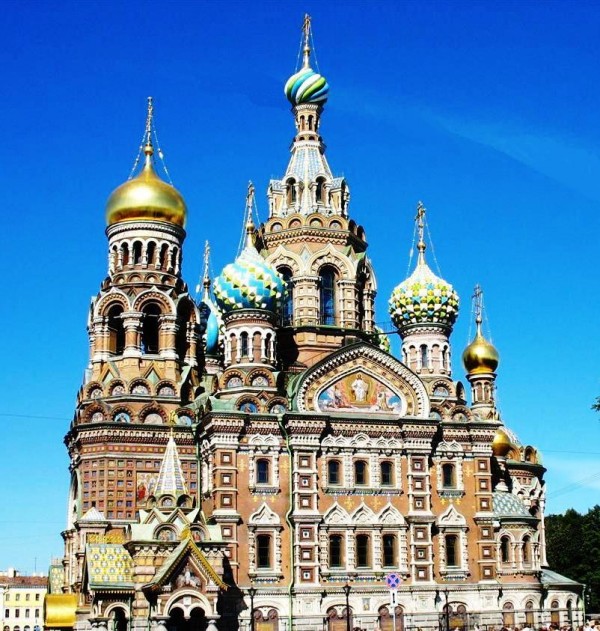 |
|
| |
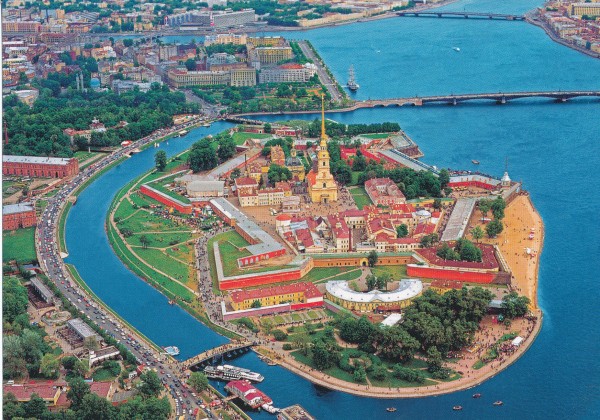
Peter and
Paul Fortress guarding the Neva River |
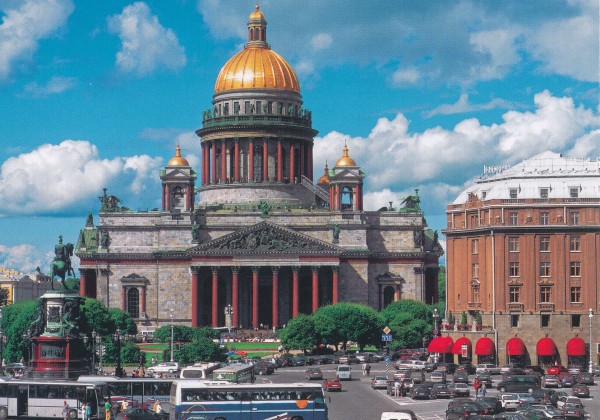
St.
Isaac's Cathedral |
| |
|
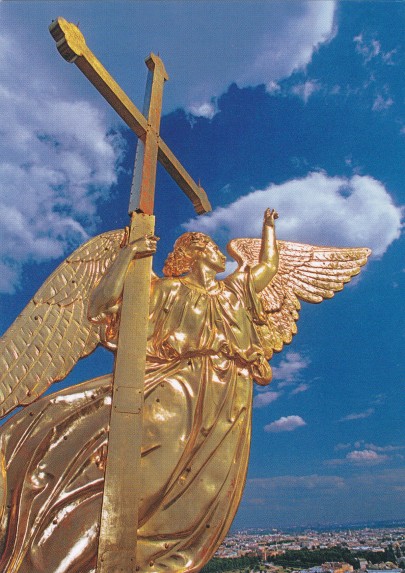
Angel of
the Spire atop the Peter and Paul Church |
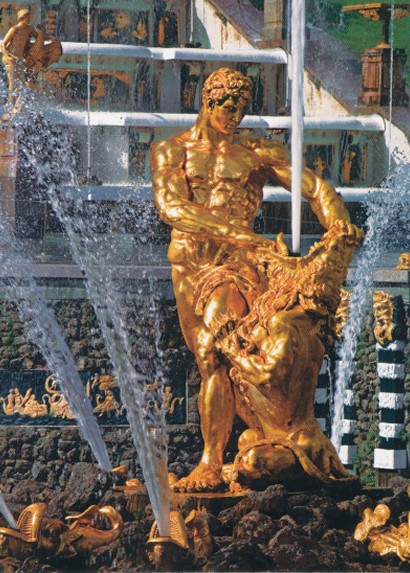
Centerpiece for the Grand Cascade at Peterhof |
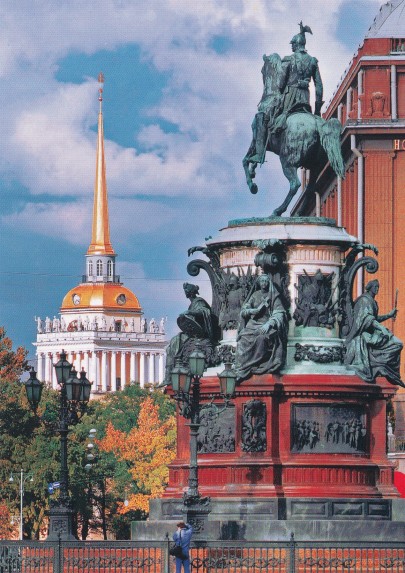
Monument
to Nicholas, St Isaacs Square |
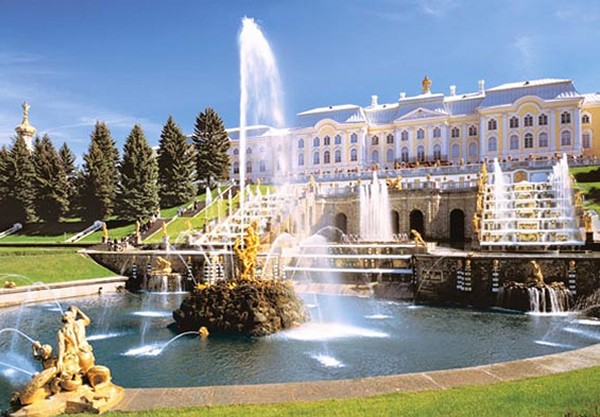
Panoramic
view of the Grand
Cascade at Peterhof |
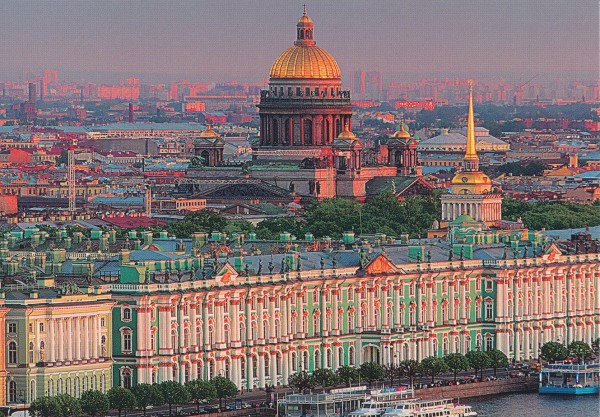
St.
Isaac's Cathedral behind Catherine's Palace |
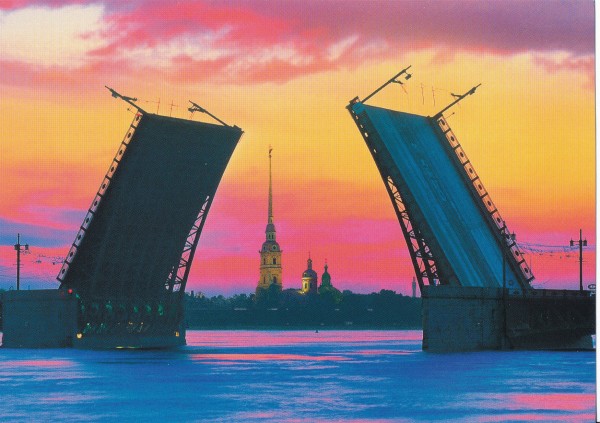
Palace
Bridge, Peter and Paul Fortress in the background |

Palace
Square and Catherine's Winter Palace (the Hermitage is here) |
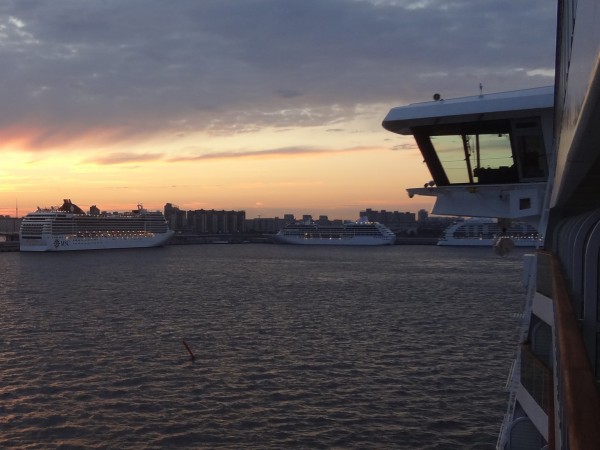
Our
day began with seven different cruise ship in the waters of
St. Petersburg. I was able to photograph three of
them.
|
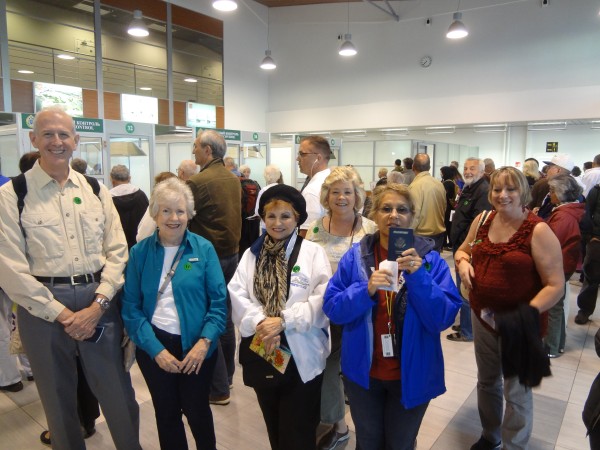
Soon enough the Usual Suspects appeared. That is Jess
and Pat Carnes, Velma, Sandra, Marla w passport, and Susan.
|
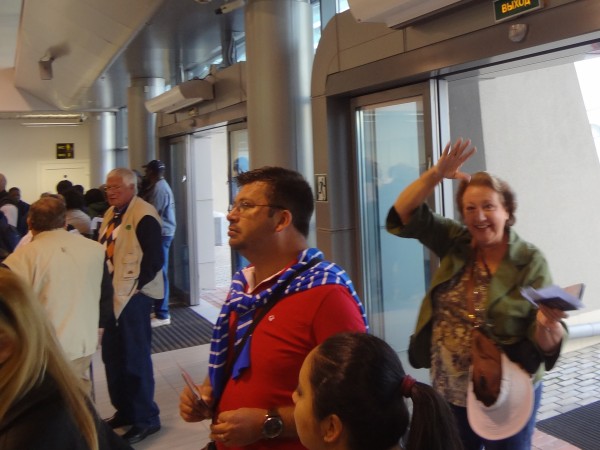
Trailing 10
minutes behind
the rest of us was Marsha. This late start was indicative of her day.
Marsha got into trouble all day long. At the end, she got so lost at the Hermitage that she had to return
to the ship with another tour group.
|
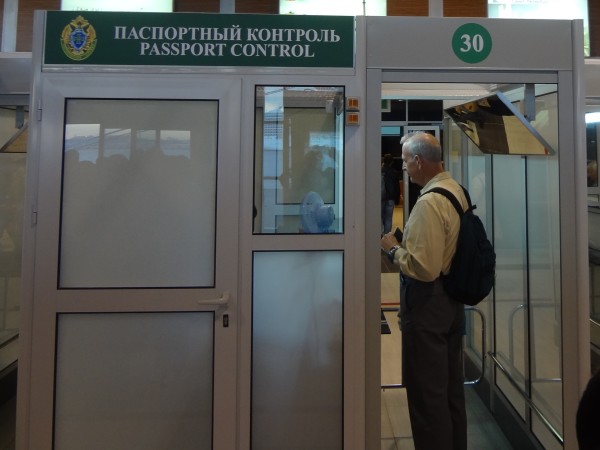
The Russian
customs agents did not smile and they viewed everyone with
supreme suspicion. Consequently I decided
NOT to take their picture. Let's not give anyone a
reason to suggest I visit a Russian jail.
|
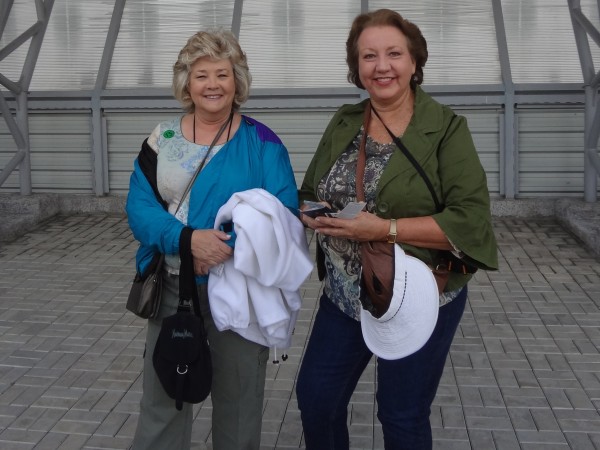
Sandra and
Marsha. Nice smiles, ladies!
|
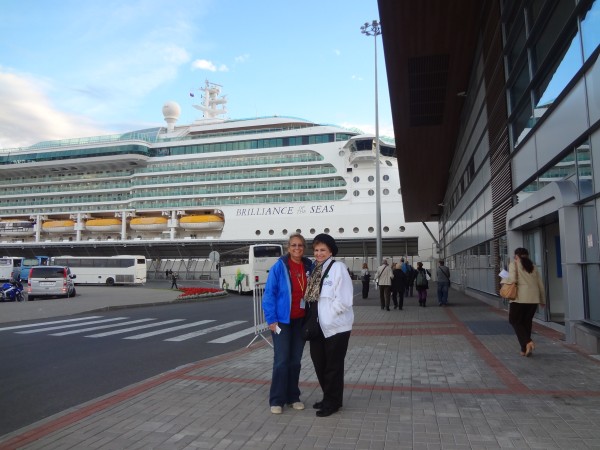
Marla and
Velma. Nice smiles, ladies!
|

The lady in
green is Tatiana, the tour guide who lost count of us. Since Marsha
was late, she was not put on our bus. Here Marsha and
Sandra are trying to persuade the lady in black to add
Marsha to our group. Marsha was eventually allowed to join
us, but I believe this is where the mix-up in the passenger
count took place.
For some reason the Tatiana decided I was the one at
fault. That figures. I get blamed for
everything.
|
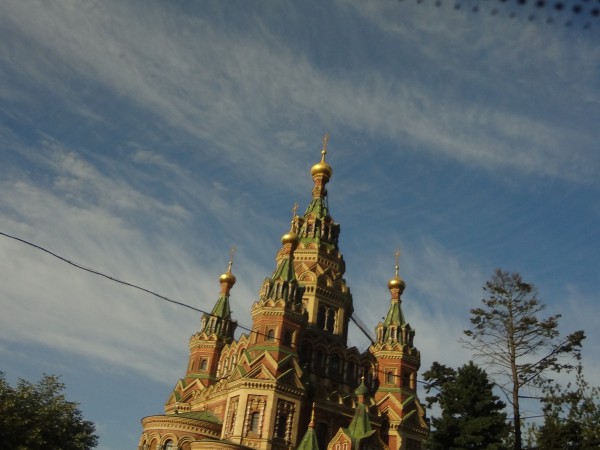
Our bus trip was
very frustrating. I was forced to take pictures of
famous St. Petersburg sights such as the Saint Nicholas
Cathedral from the bus through the tinted glass windows.
I wish we could have stopped a few times. We asked Tatiana
to stop, but we were told "it is not permitted". In
the end, I bought a postcard package of St. Petersburg
highlights. Too bad I didn't get to see them in
person.
|
|
|
|
Peterhof
The Peterhof Palace is a series of
palaces and gardens located in Saint Petersburg.
It was laid out on
the orders of Peter the Great. These
lavish palaces and gardens are
sometimes referred as the "Russian Versailles".
This is no surprise considering Peter modeled his estate on
the previous work of the French.
Peter ascended
to the throne as a teenager. However, he wasn't
interested in running the country just yet. So he
decided to let his mother run the country while he took an
18 month grand tour of Europe during 1697-1698.
Peter was both
exhilarated and depressed by what he saw and learned.
He was appalled to discover how backwards his own country
was compared to countries like France, England, Germany, and
Holland. One of his main discoveries was the
importance of having a navy for trade and defense.
Upon his return
to Russia, he was determined to modernize his country.
However, he didn't have time for originality. So he
copied Amsterdam when he built St. Petersburg and he copied
France's Versailles which had been built about 20 years
earlier.
|
 |
|
|
|
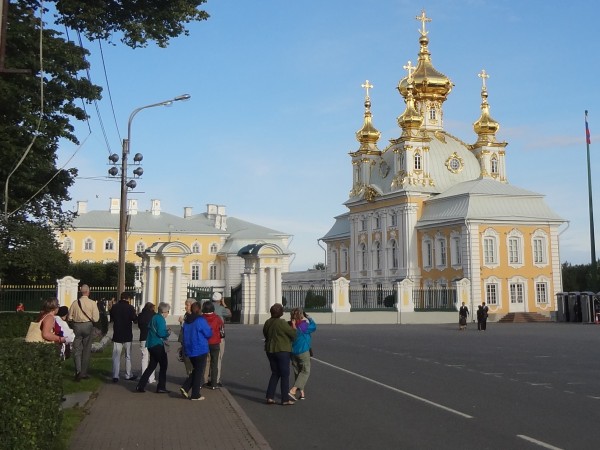
Here is our first look
at the Peterhof estate. Wow. Then someone said those spires are made of solid gold. Double Wow!
Although I
definitely agree the spires sure look like gold, I am
skeptical. I am not positive they are solid gold.
Does someone know the answer? My Internet search came
up empty.
|
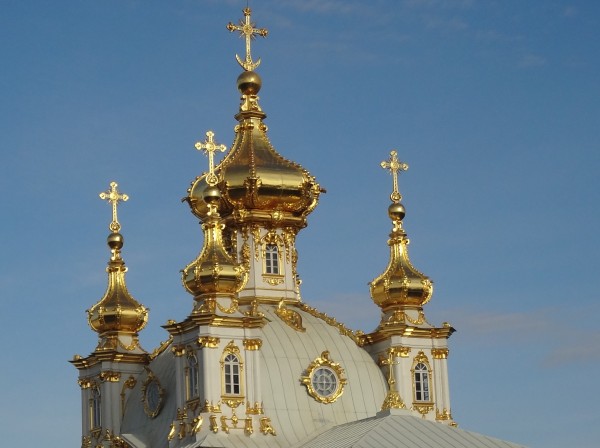
The Nazis
undoubtedly took all the original gold when they seized
Peterhof during the siege of Leningrad during WW II. (Note:
"Leningrad" was the name for St. Petersburg during the
Communist era.) Although the Russians restored the
damage immediately following the war's end, it seems likely
they would use a gold substitute to rebuild those spires.
|
| |
|
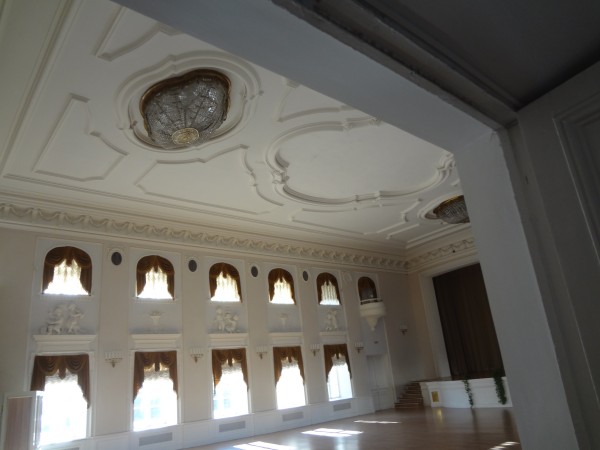
Not much of a picture,
but there is a story behind it. They were so protective of
this place that we all had to take our shoes off and wear special
socks. We were not permitted to take pictures inside the
Peterhof. There were several female guards in every room to
make sure we didn't. They did not smile and they did not take
their eyes off anyone. I saw this room and took a furtive
picture from my hip. Just then a guard appeared and stared
right at me with a frown. I died a million deaths!!
|
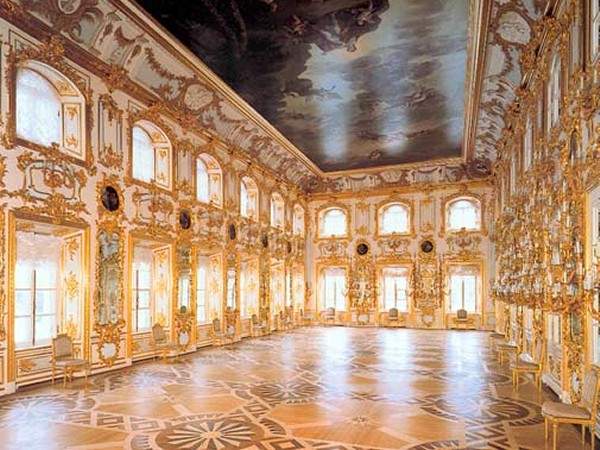
Although the guard said
nothing, I was so shaken that I didn't try that trick again.
I decided that there were pictures on the Internet,
so that seemed a safer strategy. Sure enough, I found this
picture and several more on the Internet.
Here is their Grand
Ballroom. Very beautiful. From what I gather, the
Germans looted the palace of many valuable pieces of artwork during
the siege of Leningrad. What a shame.
|
| |
|
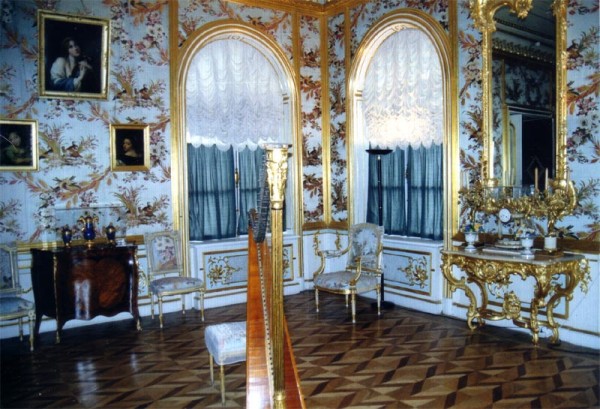
The entire interior was
styled on the French.
|
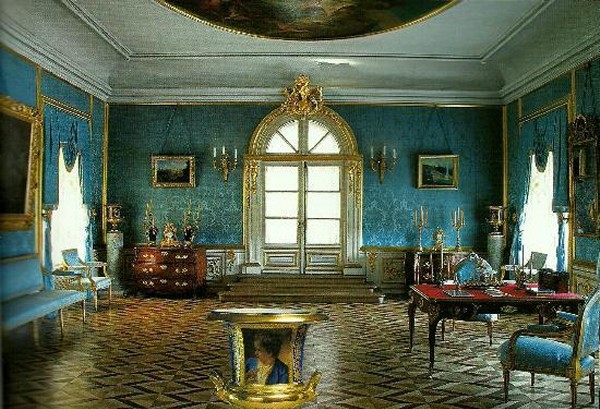
Peter's office.
|
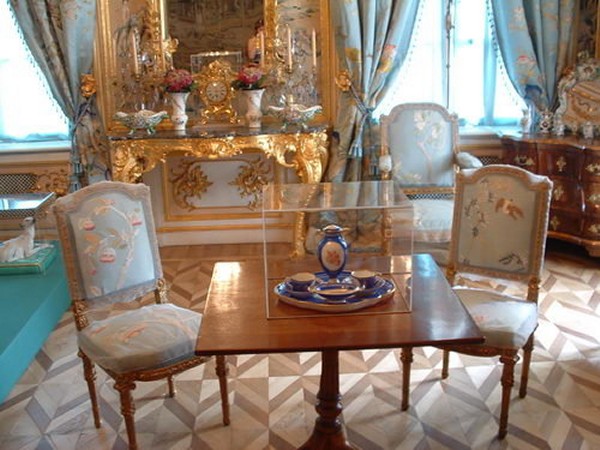 |
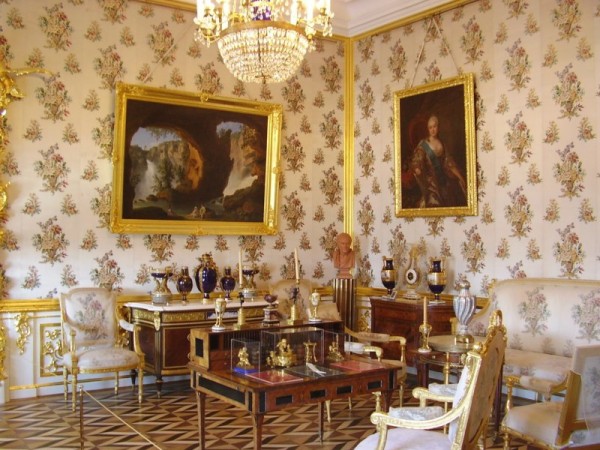 |
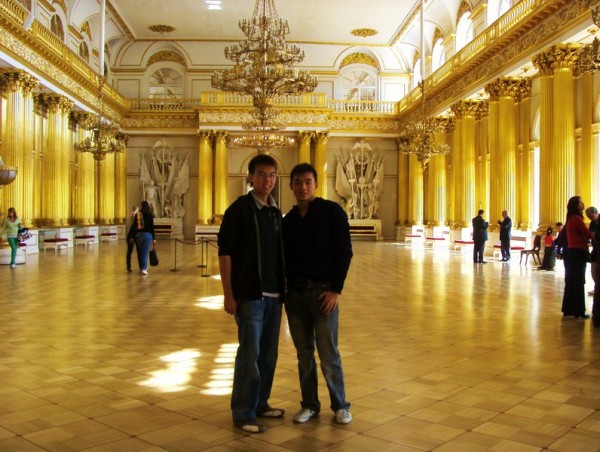
Of course my question is
why were these guys allowed to take pictures and I wasn't?
|
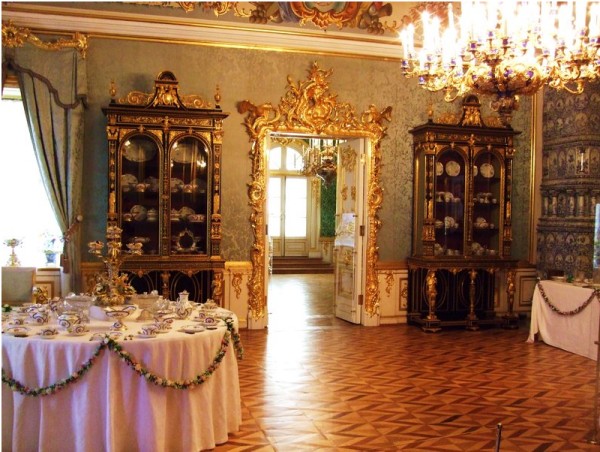
|
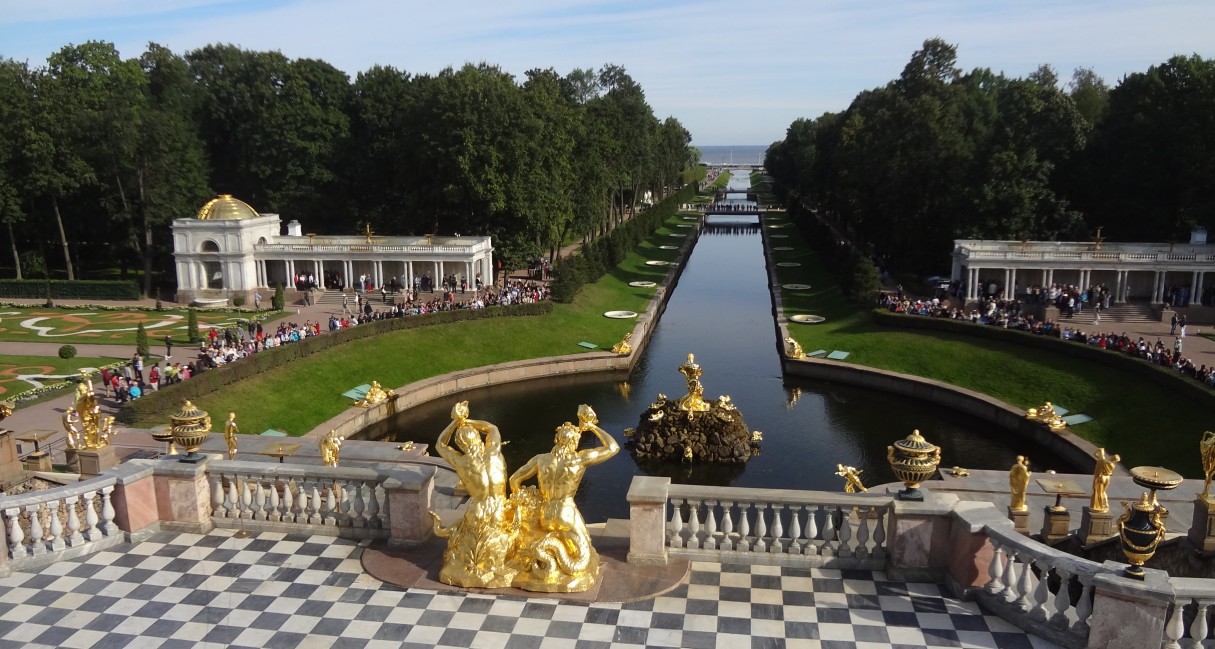
This stunning area is at
the back of the Peterhof. That water in the distance is Neva
Bay. All those gold figures turn into fountains sometime
around 10 or 11 am. When this occurs, the phenomenon is known
as "The Grand Cascade". Here people are lined up in
anticipation. The Grand Cascade is modeled on a similar display
constructed for Louis XIV at his Château de Marly near Versailles,
France.
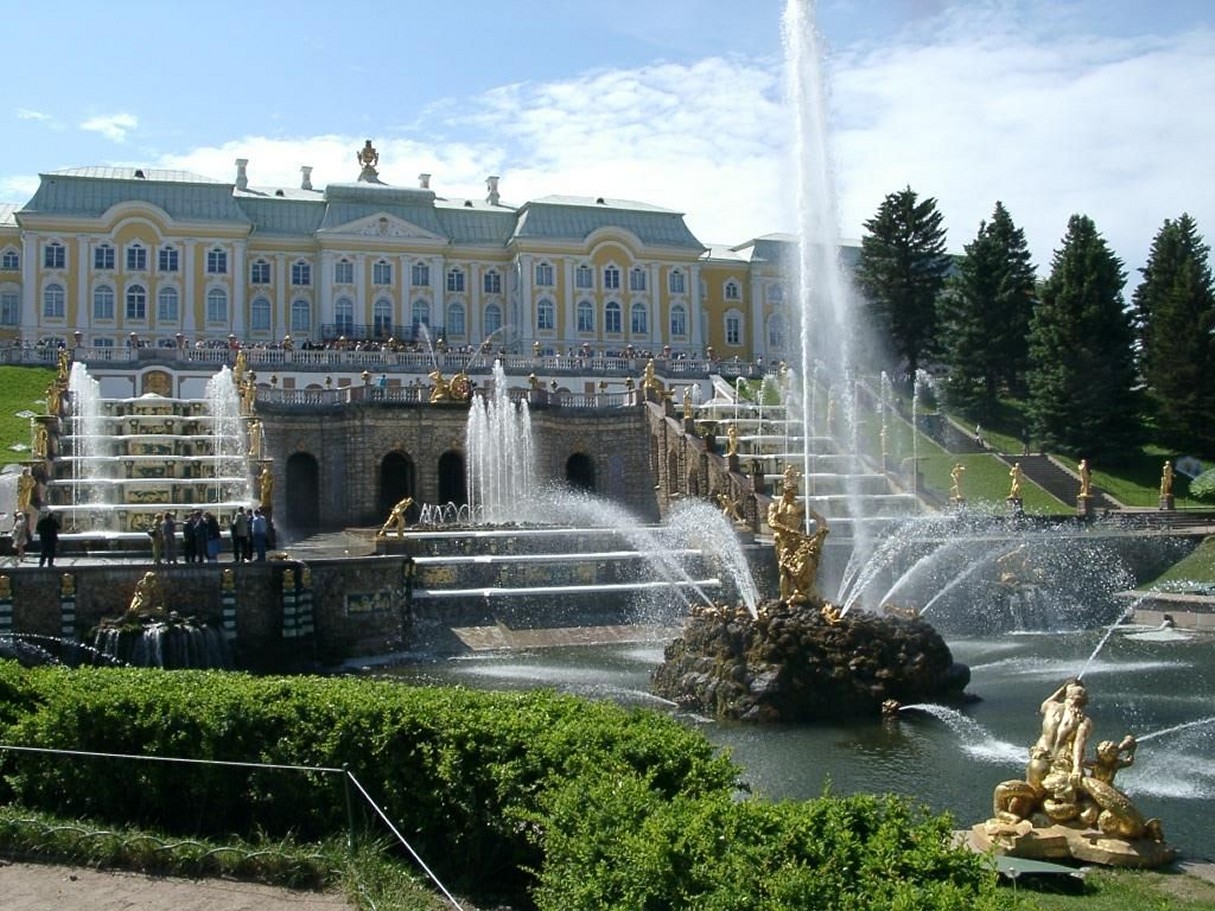
 |
The 900-day Siege of
Leningrad was undoubtedly the darkest time for this city.
Encircled by the Germans in September 1941, the city never
surrendered and it was never conquered. However the people
paid a terrible price.
Starvation and lack of heating caused the city to lose 800,000
people out of a population of 3 million. The suffering was
unbelievable.
During this time, Peterhof was captured by
German troops in 1941 and held until January, 1944. In the few months that
elapsed between the outbreak of war in the west and the appearance
of the German Army at their doorsteps, employees were only able to save a portion of
the treasures of the palaces and fountains.
An attempt was made to
dismantle and bury the fountain sculptures, but three quarters,
including all of the largest ones, remained in place. The occupying
forces of the German Army largely destroyed Peterhof. Many of the
fountains were destroyed, and the palace was partially exploded and
left to burn. This totally unnecessary damage only added to
the deep hatred the Russians held for the Nazis.
As you will see, the
Russians had their own form of revenge. We will get to that
shortly.
Fortunately restoration
work began almost immediately after the end of the war and continues
to this day. As a result, much of the building and statuary in
Peterhof has been restored and new gilt-work abounds.
In 2003, Saint Petersburg celebrated its 300th anniversary.
The building of Saint Petersburg in 1703 was one of Peter the Great's most
notable achievements. The defeat of Sweden in the
Great
Northern War made it possible for Russia to gain its first access to
the Baltic Sea. In this sense, Peter's Grand Palace is a
Russian trophy that symbolizes the imperial expansion and
modernization of Russia.
|
In the 1730s, the large Samson Fountain was
placed in this pool.
The fountain depicts the moment when Samson tears open
the jaws of a lion (see above).
It symbolizes Russia's victory over Sweden in the
Great Northern War.
The lion is an element of the Swedish coat
of arms, and one of the great victories of the war was won on St
Samson's Day. That is a
65 foot vertical jet of water shooting
upwards from
the lion's mouth.
This masterpiece by Mikhail Kozlovsky was
looted by the invading Germans during the Second World War. A replica of the statue was installed in
1947.
|
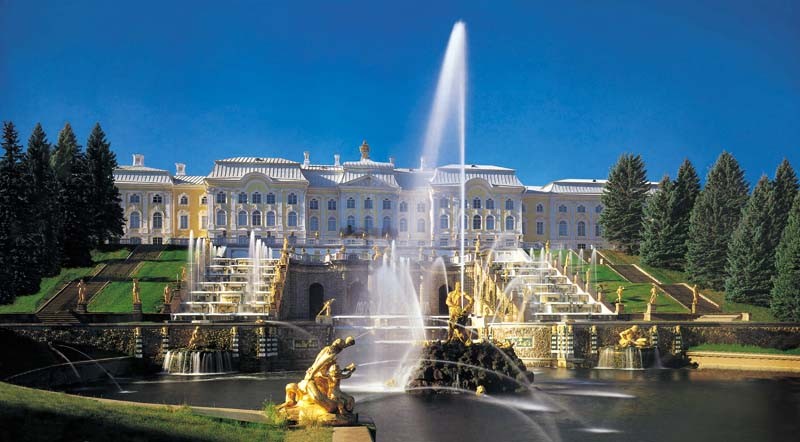 |
| |
|
This picture gives some
idea of the huge throngs that gathered around the fountain to take
pictures and get a better view. I tried very hard to get close
enough for some good pictures, but it was impossible. Finally
I gave up and made the same decision I made inside...
I would go to the Internet when I got home and get a good
picture there. Sure enough, worked like a charm.
I got separated
from the group while trying to get my pictures. Our tour guide Tatiana had a fit
with my wanderings. She wanted everyone to stay
in a tight knit group so I got chewed out when I returned
to the group. I tried to explain the importance of getting
good pictures, but Tatiana was definitely unhappy with me.
Our second run-in came
as we were going to lunch. Tatiana wanted to know where my
green tour sticker was. Well, it was on my Houston Rockets
pullover that I left back on the bus because it was warm now.
Tatiana didn't believe me. Right in front of the group she
chewed me out for not having my sticker.
For a second I thought I
would have to go back to the bus and get the sticker to prove I
belonged. Tatiana did not back
down till the group assured her I belonged with them. It was
these two incidents that convinced Tatiana that I must be
responsible for causing her to lose someone. Wrong.
It was Marsha's fault. Marsha was the CIA spy, not me.
Don't shoot me, shoot her!
|
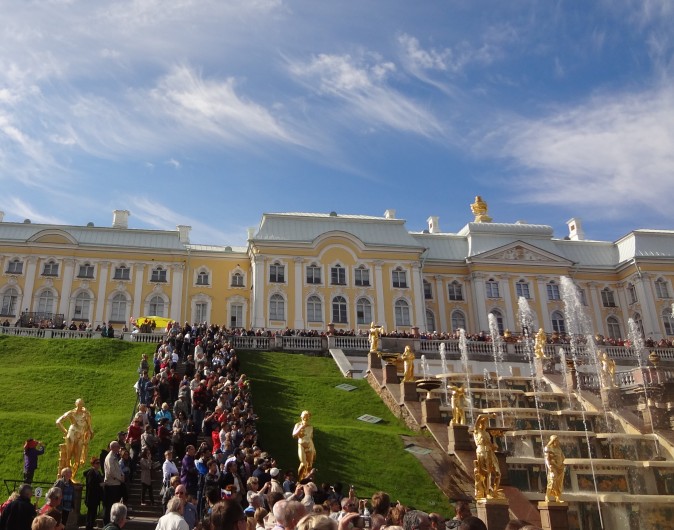 |
| |
|
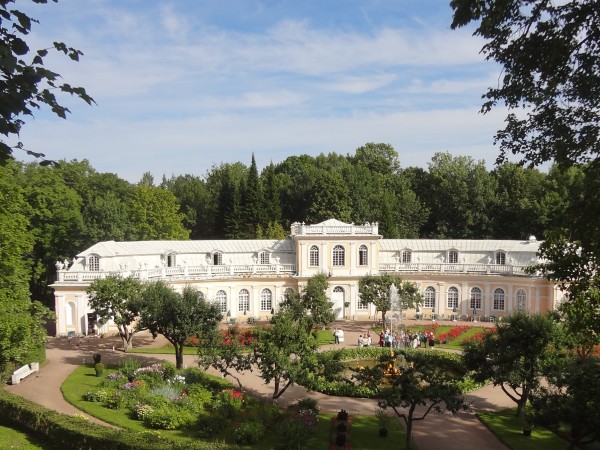
Here is yet another part
of the vast Peterhof estate. Maybe this is the guest house.
There just wasn't enough time to see it all. This place was a
mile wide and over half a mile deep.
|
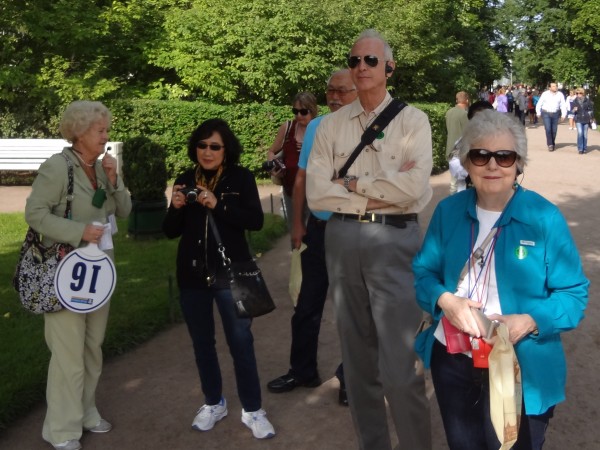
Here is our friend
Tatiana the tour guide looking befuddled as usual. I have
little doubt she is still trying to figure out why she is missing
a tour ticket for one person.
|
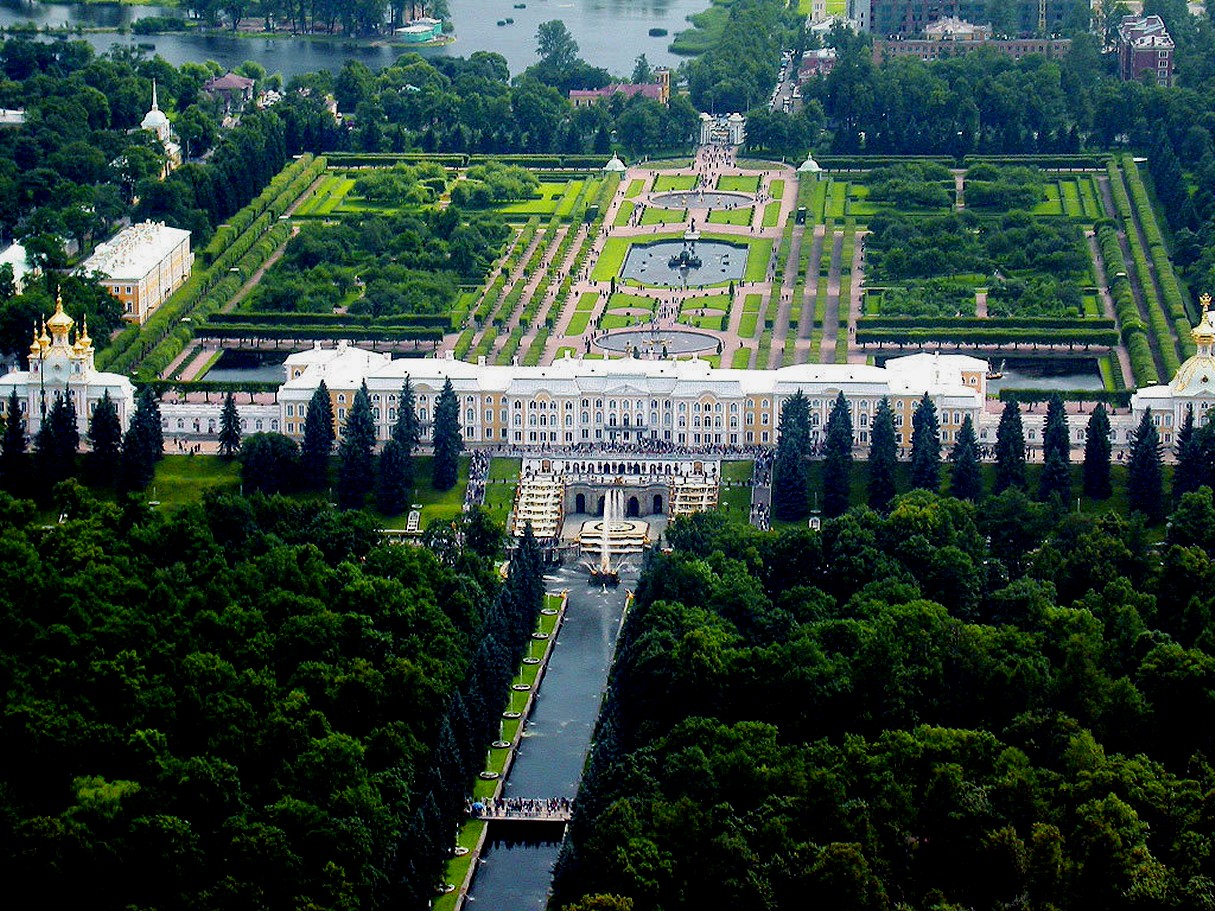
This aerial view of
Peterhof does a good job of conveying the immensity of the estate.
I might add this picture fooled me. It shows the Grand Cascade
in front and the magnificent tailored gardens in back complete with
a large body of water. I wondered if the water at the back of
the picture was Neva Bay. Was I turned around? I had
to go to Google Earth to figure it out. The Grand Cascade is
indeed in the BACK of the estate and that canal brings water
from Neva Bay to the fountain. The water on the other side is
a lake named Olgin Prud.
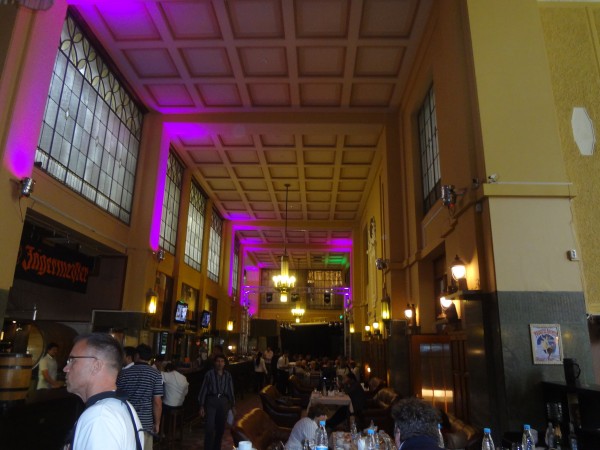
After Peterhof, it was
lunch time in this giant dining hall back in the city.
|

Marla isn't smiling
because she is really hungry. I spent most of my lunchtime
begging for extra shots of vodka. Yum!
|
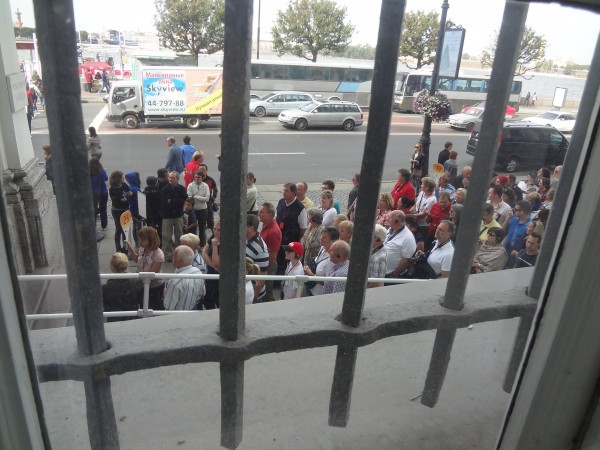
We were forced to wait
in line at the Hermitage for at least half an hour. With seven
cruise ships in the harbor, there were at least 15,000
tourists spread throughout the city.
|
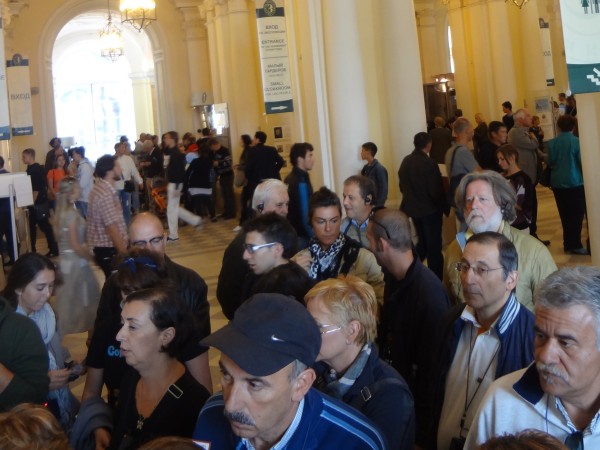
I was fairly certain 14,000 of them visited the Hermitage at the same time we did.
Marla agreed. She said the lines to the ladies room were even longer than
the lines outside.
|
|
|
|
The
Hermitage
From what I gather, the
Hermitage is St. Petersburg's most popular visitor attraction.
Personally, I enjoyed Peterhof more, but I could see why the
Hermitage would be quite a draw.
The Hermitage is one of
the world's largest and most prestigious museums. With over 3
million items in its collection, there is everything from
Impressionist masterpieces to fascinating Oriental treasures.
One estimate has it that you would need eleven years to view each
exhibit on display for just one minute. Consequently visitors prefer to
attend a guided tour to ensure they have time to catch all the
collection's highlights.
Catherine the Great
ruled in the latter half of the 1700s. She founded the Hermitage in
1764.
Catherine loved art and made collecting it her
hobby of sorts. Catherine bought artwork en masse from various European
aristocrats who needed money more than they needed their valuable
artwork.
Her collection was embellished by each of her successors.
It became a pet project of the Romanovs to add to the work of their
illustrious predecessor. The Hermitage benefitted greatly from
the fact that the works of the French Impressionists weren't quite
as expensive back in the 1800s as they are today.
The greatest growth spurt occurred at the end of World War II.
Shortly before the Siege of Leningrad began in 1941, the Russians were
able to smuggle away the most important pieces of art. Two
trains with a considerable part of the collection were evacuated to
Yekaterinburg in the Ukraine (the same city where Nicholas and
Alexandra and their family were murdered).
Although the Germans were able to
capture Peterhof on the outskirts of the city, they were unable to loot the
remaining
Russian art treasures in the Hermitage thanks to the refusal of the
Russian people inside the city to surrender.
At the end of the war Russia turned the tables
on the Germans. By
reaching Berlin well in advance of the Allies, Bolshevik
confiscations and Red Army seizures in conquered Germany massively
enriched the Hermitage collection.
As one might guess, this
is a sensitive topic still today. The Germans want their art
back. On the other hand, the Russian point of view is that
Germany ransacked Russia art for five years and destroyed 500
museums in the process. After looting many thousands of art
treasures from the Soviet Union, Russia can hardly be blamed for
looting in return after Germany lost the war.
Russia wouldn't mind exchanging stolen cultural treasures, but a lot
of what the Nazis took is now in private hands. Meanwhile the
Germans estimate that 500,000 stolen artworks, books and archives
remain in Russia. Naturally the Russians say about the same number were
looted by the Nazis. Stalemate.
Considering the
devastation caused by the Nazis, if I were a German, I wouldn't be
holding my breath awaiting any returns. Considering how
much of Russia was destroyed by Nazi invasion and 20 million people
died during the war, Russia is not in much of an obliging mood. I am not a big fan of
Russia, but I can certainly see their point on this issue.
Spoils of war.
There were several
lessons I learned during this visit. I learned that I liked the
statues a lot.
The next thing I
learned was that I was supposed to turn my camera flash off. Apparently each flash does
some sort of microscopic damage to the pictures. I did not learn this till late
in the day when one of the monitors hissed at me. Oops.
The collection is
incredibly varied. It ranges from Egyptian antiquities, Greek
statues, and Siberian artifacts to Italian Renaissance and Dutch
classics. Perhaps the most impressive part of the collection
are the post-impressionist masterpieces by Matisse and Picasso.
Also featured are works by Renoir, Monet, Van Gogh, Gauguin,
Pissarro, Cézanne , Sisley, Morel, and Degas.
Unfortunately I am not
much on art history, so no doubt I walked right past some of the
greatest pieces of art imaginable and had no idea what I was
missing. In addition, I have no idea who did most of the
pictures because I was too stupid to photograph the artist's name
sitting beside the picture.
I also learned that I prefer
history to art. My favorite section was the art related to the
events of Catherine's reign. When the paintings of the tsars
and generals of Catherine's era appeared, I got all sorts of
goosebumps. I had spent considerable time studying Russian
history from the time of Peter the Great through Napoleon's invasion
of Russia. Suddenly I saw paintings of these historical
figures and grinned broadly. My heroes!!
|
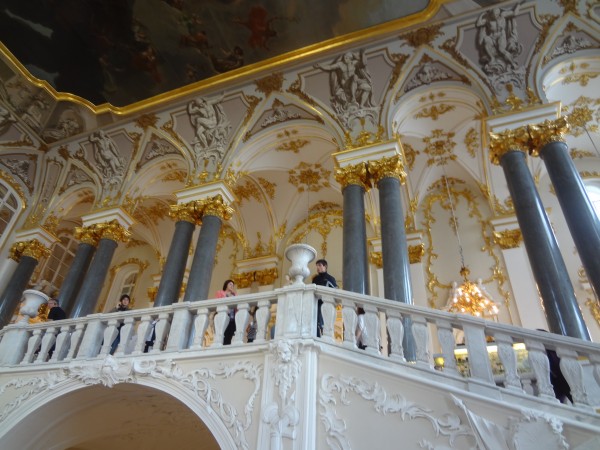

Catherine the Great, Founder of the Hermitage
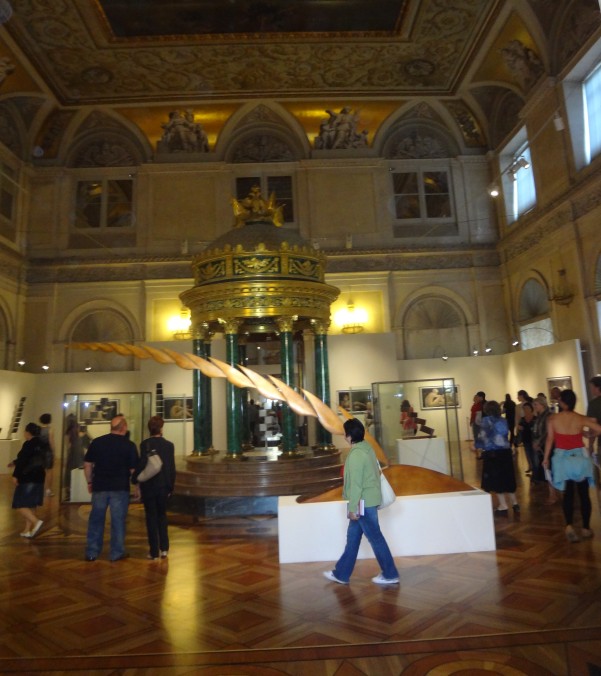 |
| |
|
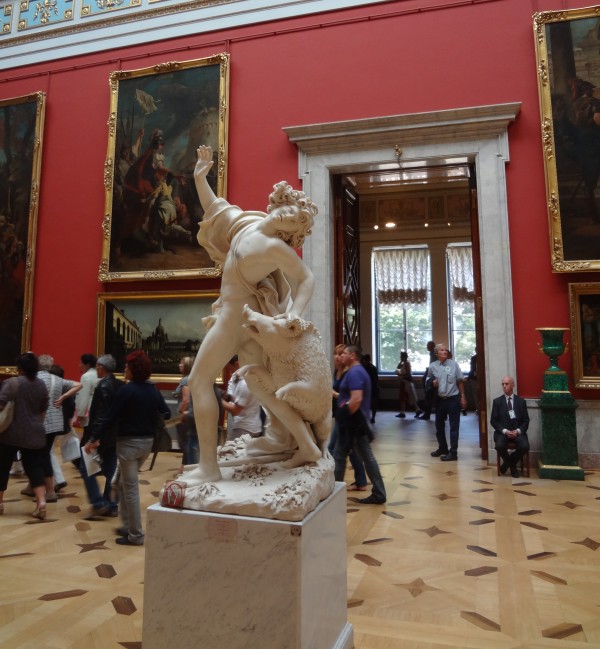
Notice the guard sitting
at attention. There were often two to a room.
|
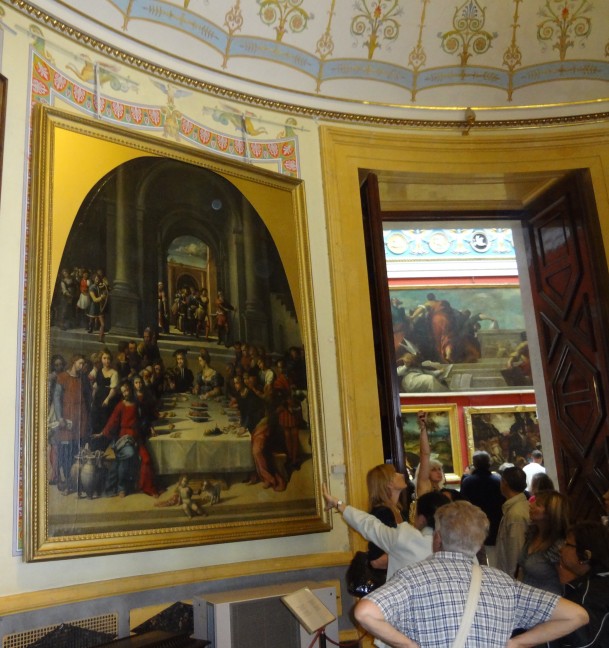
Here is an example
of a picture I liked, but forgot to get the artist's name.
I have no idea who painted it.
|
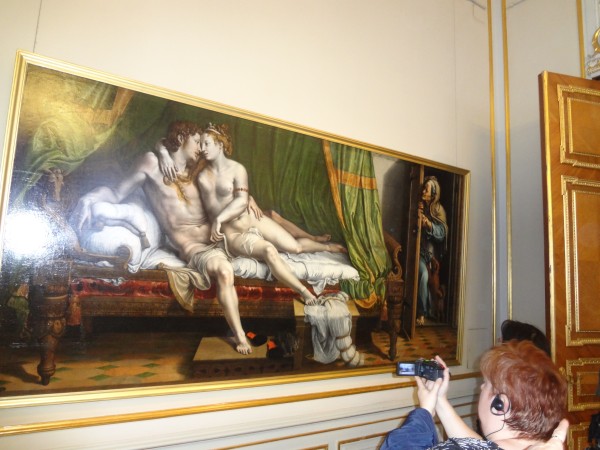
Here is an example of
how using a flash damages the painting. Not only does the flash ruin the picture's appearance,
according to Wikipedia, the
light from a flash/strobe has a high concentration of UV light. This
decomposes the pigments used in paints and dyes by fading and
bleaching them over time.
|
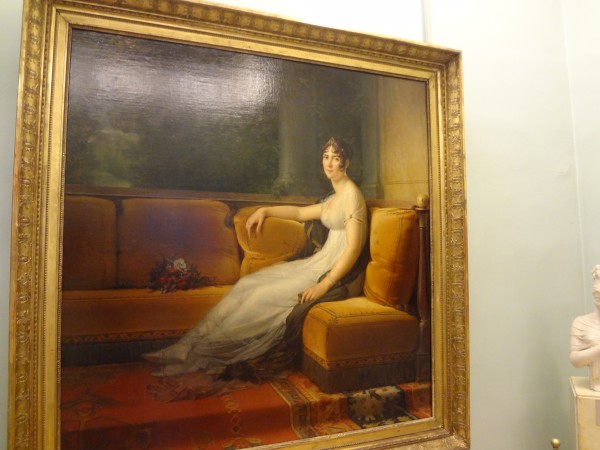
Later I learned to stop
using the flash. I was relieved to find I could still get a
pretty good picture. Incidentally, the light in this picture
is merely a reflection of the light in the ceiling above. And
who exactly drew this picture? Beats me. I still had not
learned the need to photograph the artist's name.
|
| |
|
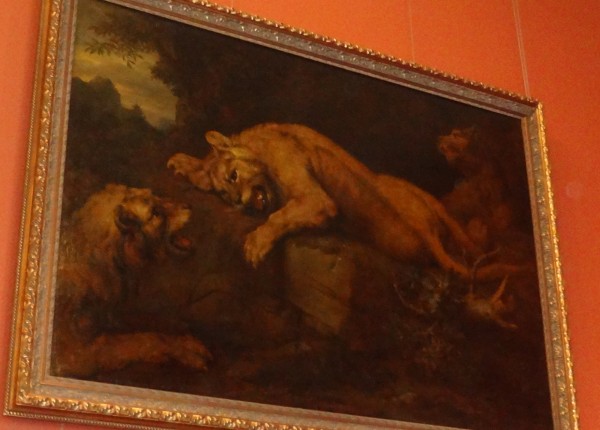 |
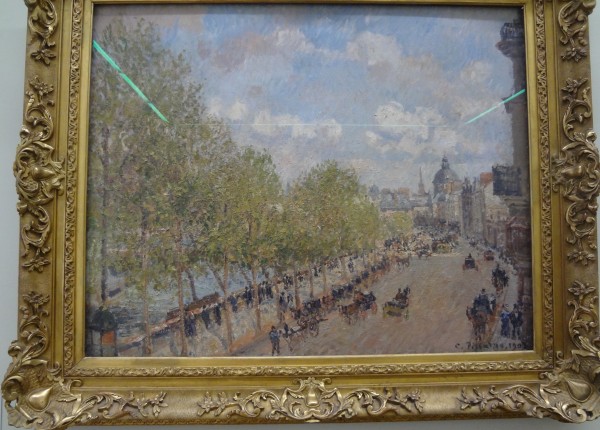
Camille Pisarro, "Sunny
Afternoon"... this was the first painting where I thought to photograph
the name of the artist.
|
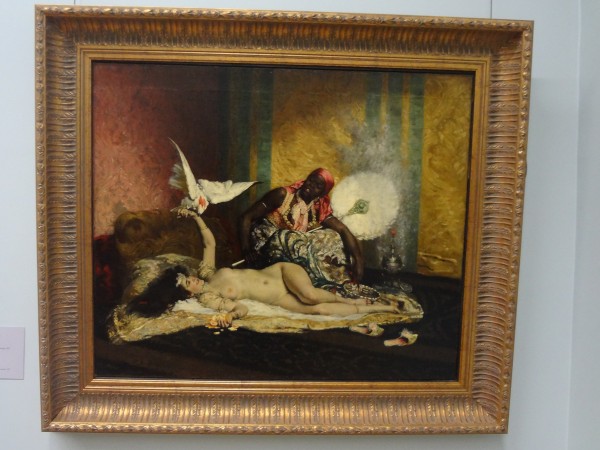
Ferdinand Roybet,
"Odalisque"
|
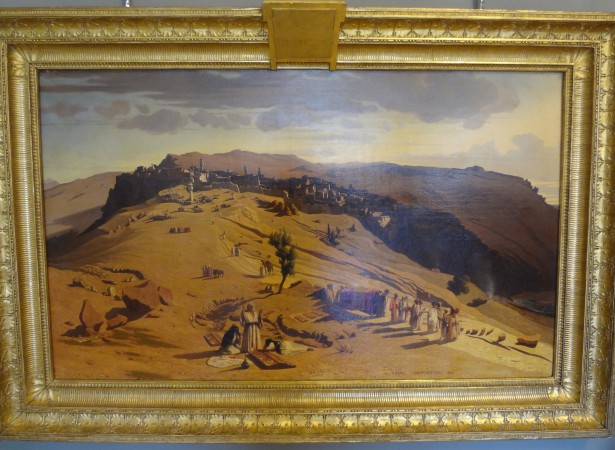
By Charles somebody,
"Constantine the Great"
|
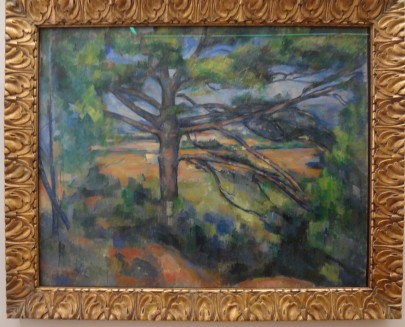
Paul Cezanne, "Large
Pine near Aix"
|
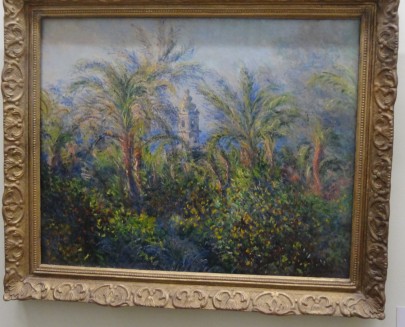
Claude
Monet, "Garden
in Bordighera"
|
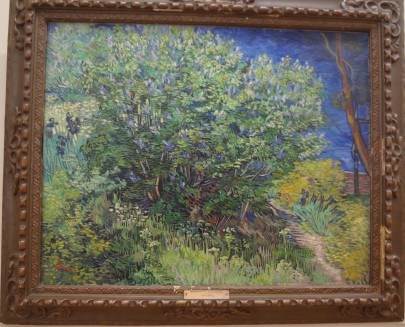
Vincent Van Gogh, "Bush"
|
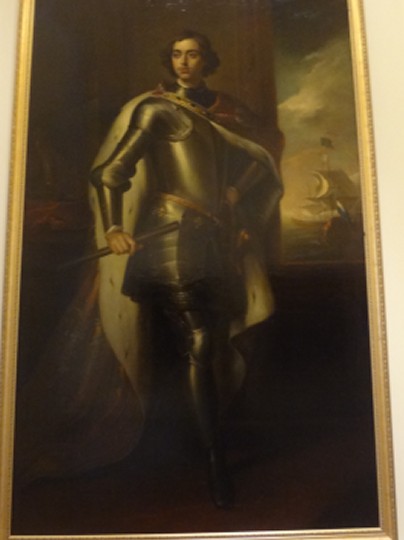
Now we get to my
favorite part. Take a wild guess who
this is.
Peter the Great ruled from 1682-1725. Russian history is divided into two sections - Before Peter and
After Peter. Too bad he was such a thug. Peter murdered his
own son!
|
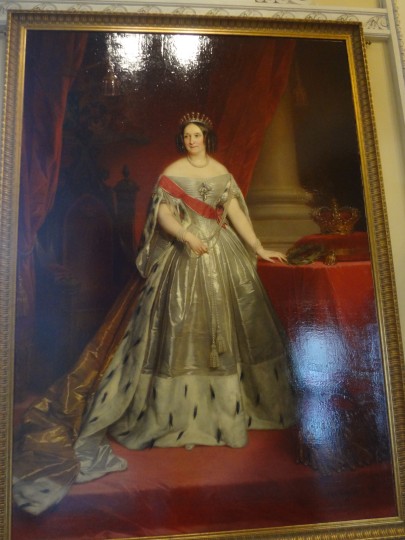
Peter was succeeded by
this nutcase known as Anna. She was his niece. Anna
ruled from 1730-1740. She was basically a pretender to the
throne. One day her cousin Elizabeth, the actual daughter of
Peter, decided she had enough. She told Anna to leave. Poof!
Russia had a new Empress.
|

This is Elizabeth. Known for her great beauty, Elizabeth
restored dignity to the leadership of Russia. She ruled from
1741 to 1762. Elizabeth brought dancing and
the Grand Ball to Russia. She wore five dresses a day, but
never the same one twice. Elizabeth never married and left no heir.
|
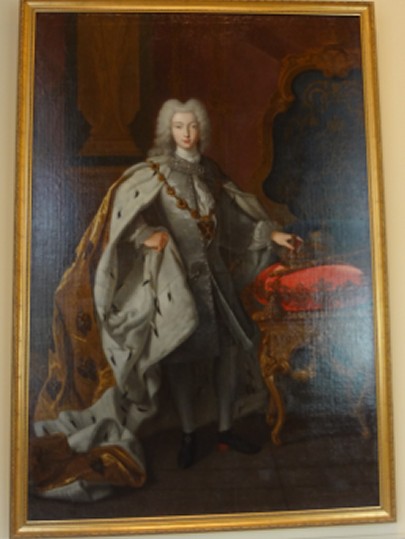
This clod is Peter.
There were all sorts of things wrong with him. He took over
when his aunt the Empress Elizabeth died. He only ruled for six
months. He made such a mockery that his wife Catherine had him murdered.
|
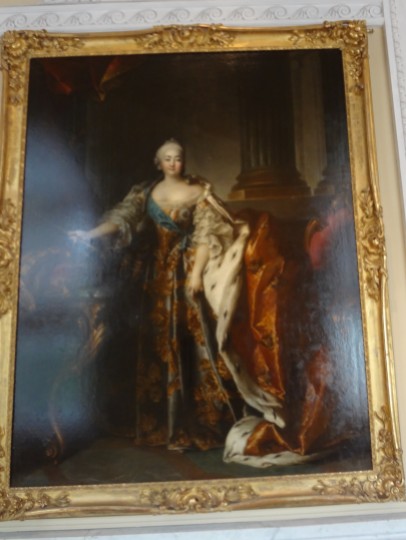
Catherine was a nobody
until she got her boyfriend to murder her husband. The next
you know, she's Catherine the Great! It is very likely
the Romanov bloodline was broken here. You really should
read the
story I wrote about her. It is very interesting!
|
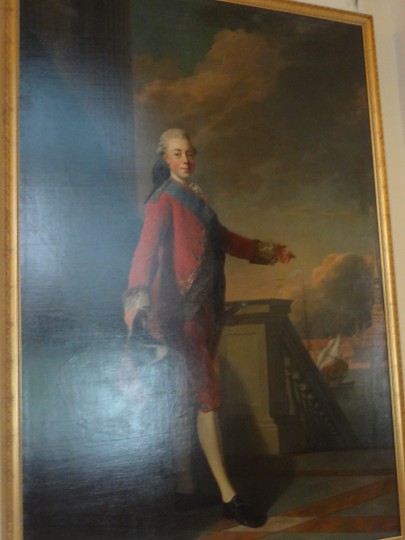
Catherine was succeeded
by her son Paul. More than any other emperor in Russian
history, Paul spent his entire life preparing to lead Russia.
But he made a mistake - he told his mother he was going to change
her policies. Five years into his reign he was killed.
|
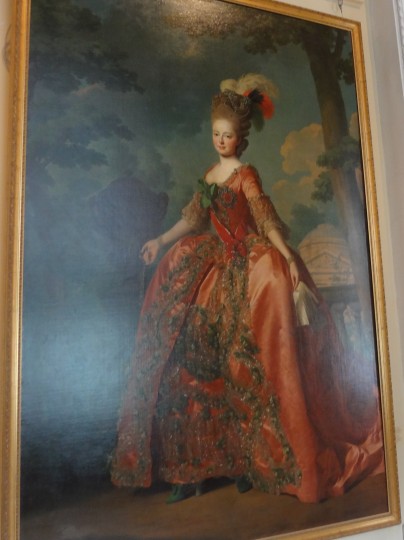
This is the first Maria
Fedorovna. She was the wife of Paul, Catherine's ill-fated
son. After her husband Paul was assassinated, the next two
tsars were her sons Alexander I and Nicholas I
|
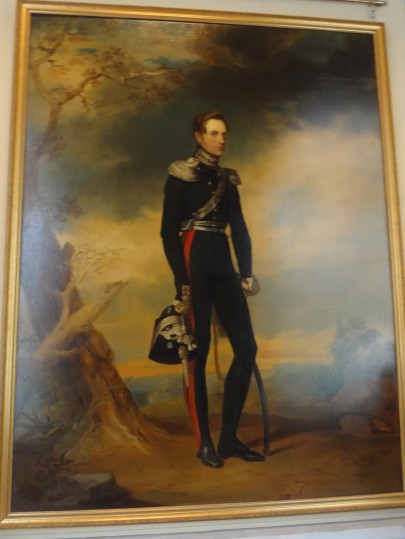
This is Alexander I.
He became Tsar at a young age when powerful Russian boyars decided
to have his father Paul assassinated. Alexander was in another room
at the time. Good story!
|
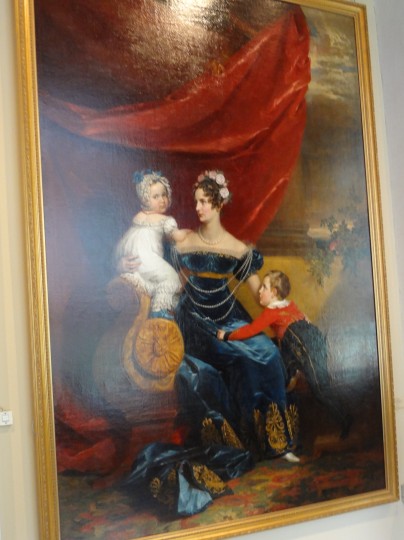
This is Louise, the wife
of Tsar Alexander I, and her two children. Alexander was Tsar when Napoleon went
down to his stunning defeat.
|
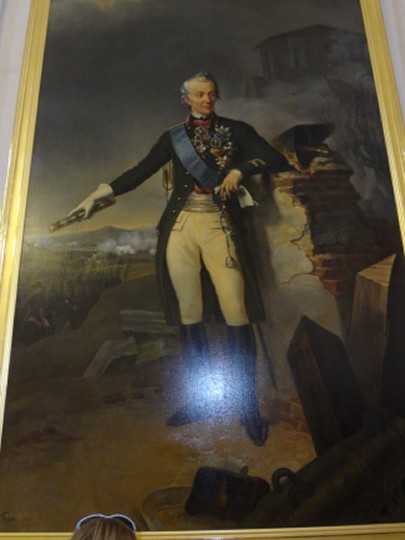
This is Alexander
Suvorov, the commander who served under Catherine the Great. He fought
against Turkey's Ottoman Empire in the 1700s during a period of Russian
expansion begun by Peter the Great. One of the reasons
Catherine was "Great" was due to having Suvorov lead her armies.
Suvorov retired undefeated at 63-0. Not bad!
|
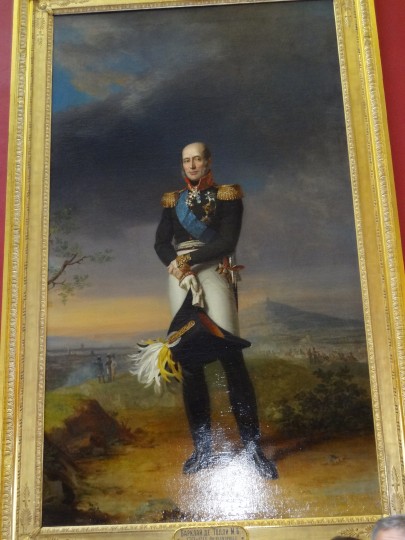
My favorite part
of the collection were these paintings of the war heroes from
Napoleon's 1812 invasion of Russia. I had just finished
studying these guys before our trip. This is Barclay de Tolly,
the man who had the guts to stick to the scorched earth policy that
brought the mighty French army to its knees. However, since the
Russians starved too, de Tolly was despised.
|

Here is General Kutuzov,
the man credited with handing Napoleon his first-ever defeat in a
major campaign. Under Kutuzov's command, the Russian army fought the
French Grande Armée at Borodino to a draw. After burning
Moscow, the French were trapped. The counter-attack pushed the French
out of the Russian homeland. This is an incredible story.
Road to Moscow
|
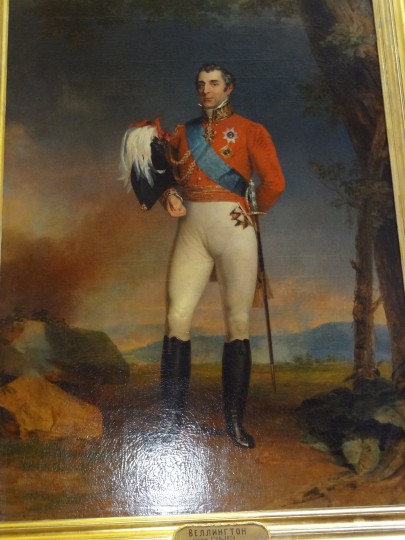
This is the Duke of
Wellington, Sir Arthur Wellesley, the man who defeated Napoleon at
Waterloo. After Waterloo, Wellesley tipped his hat to the
Russians. It was the Road to Moscow three years earlier that
had started Napoleon's downward spiral.
|
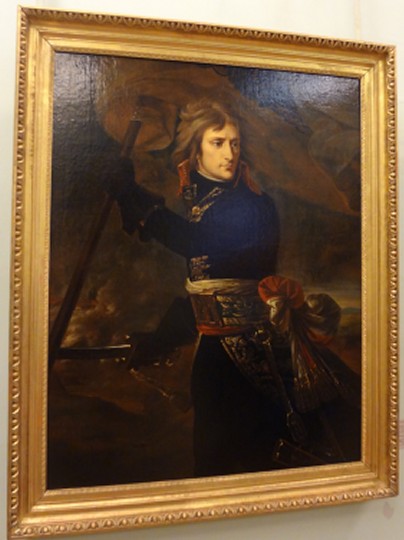
Speak of the devil.
Yes, even Napoleon has his painting hanging in the Hermitage.
Napoleon had all of Europe except for England and Russia under his
thumb. No one dared make a move against him until his
failed effort in Russia
opened the door.
|
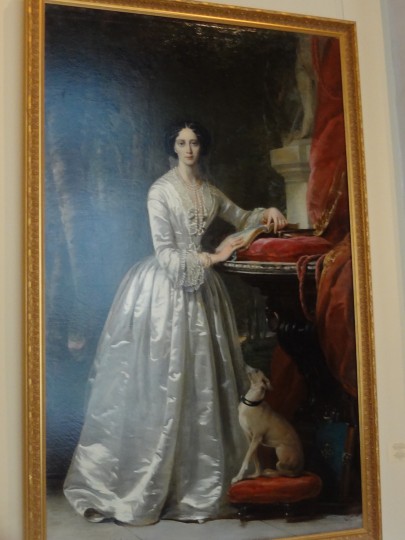
This is the second Maria
Feodorovna. She was the mother of Tsar Nicholas II, the man
who was murdered in the Russian Revolution along with his wife
Alexandra. Russian history is so fascinating! I again
invite everyone to read my 5 chapter
History of Russia.
|
|
|
|
Tatiana and
Marsha the Spy
If you look, Jess is
standing next to the wall and his wife Pat in blue is taking a
picture. Can you see Marla waving
to me? Velma is in red with the black hat right next to Marla.
You can also see Marsha
the Spy
staring up at me. Marsha needed a cover story to explain her
disappearance at the Hermitage. You know and I know what
Marsha was really doing, but it would be dangerous to write about
it. To cover her tracks, Marsha claimed she was badly
lost during our visit. Considering how crowded
it was and how easy it was to lose track of the group, Marsha's disappearance
was a plausible enough story.
There is our tour guide Tatiana with her #16
sign. Tatiana was fairly worthless all day long. I found
it interesting that her knowledge of Russian history and my
knowledge clashed on several occasions. For example, Tatiana told
some preposterous tale of how Tsar Peter III was removed in a
bloodless coup.
Nonsense. His wife Catherine the Great had her boyfriend
assassinate him. I concluded that Russian history was still
being whitewashed and sanitized here in Russia. That's
probably a good thing because nearly 33% of all the Tsars were murdered
and 33% of the other Tsars murdered someone else to remove them from the
succession chain. Pretty gruesome stuff.
Tatiana had some sort of
wireless listening device for us, but
it didn't help. She knew very little about the paintings at the
Hermitage and who could understand her anyway with her accent and
all the noise around us? I decided to tune Tatiana out and
just go look at whatever I found interesting. I kept the
listening device on simply to help keep track of the group's
whereabouts.
This tactic made
for some interesting moments. If I looked at a picture for one
moment too long, it was easy for the group to disappear. The
moment the group turned a corner, the sound vanished. I would be reading about
a painting in a different part of the room only
to hear the sound disappear. I would look around in a panic.
Which way did they go? There were crowds
everywhere and four exits to every room.
Now I had to guess which exit they took. If I guessed wrong,
now I had to sprint back to the room where I lost them and try
another door.
My frequent
searches added some real excitement to my day. Only one problem.
Now only did my behavior drive control-freak Tatiana nuts, it
irritated Marla too because Tatiana invariably took out her
frustration on Marla. "Where's your husband? Where did
he go this time? Will you please keep him with us?"
Well, I always managed
to find the group, but Marsha wasn't so lucky. I think Marsha's
downfall came when she went to the restroom. That was the last we ever saw of her at the
museum.
From what I gather,
going to the restroom was quite an adventure.
The restroom was down these stairs. Marla told me a tale of
some Japanese woman who kept letting her friends cut in line.
This is irritating enough when you are forced to wait longer, but it
is especially maddening when you have to go.
The only reason Marla
didn't get lost was she told me to position myself halfway between
Tatiana and the women's restroom. I could still barely hear
Tatiana's voice this way.
This was our Hansel and Gretel
trick to keep from losing Marla the same way we lost Marsha. Poor Marsha wasn't so
lucky. She got stuck in the long line at the lady's restroom, lost
audio contact with the group and never did find her way back.
Fortunately, Marsha did
have a cell phone. This saved her. Marsha and her friend Sandy
were able to stay in contact. However neither woman knew the
vast Hermitage well enough to establish some sort of
meeting point. Marsha kept wandering around hoping to run
into us. No such luck. Or so she says.
Once Marsha stumbled across another Royal
Caribbean group exploring a different part of the museum, she begged
the tour guide to give her a ride back to the ship. This
solution worked out just fine. Marsha called Sandy back and
said not to worry.
|
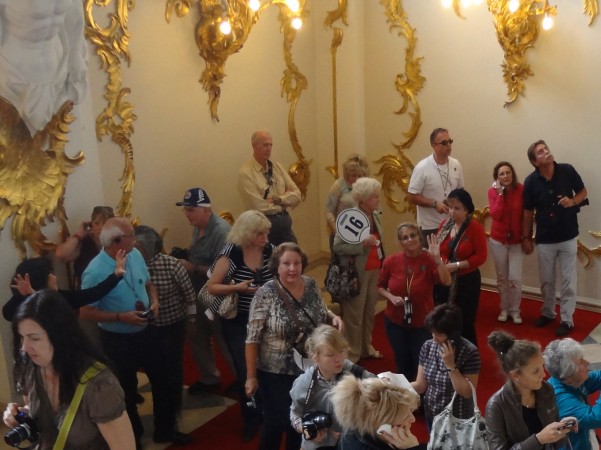
Jess, Pat, Tatiana,
Marla, Velma, and Marsha the Spy
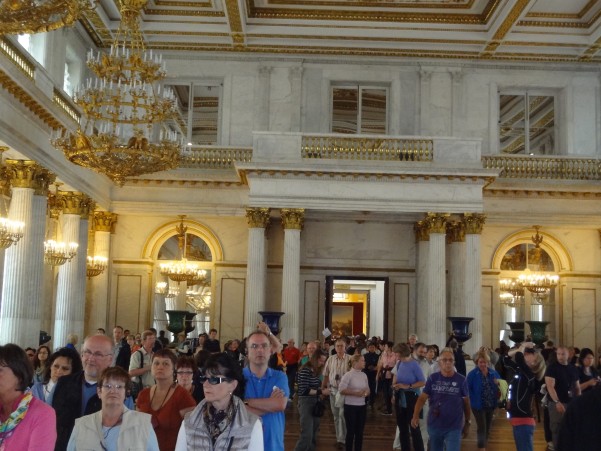
The
Hermitage was ridiculously crowded.
Every room was full of wall to wall people.
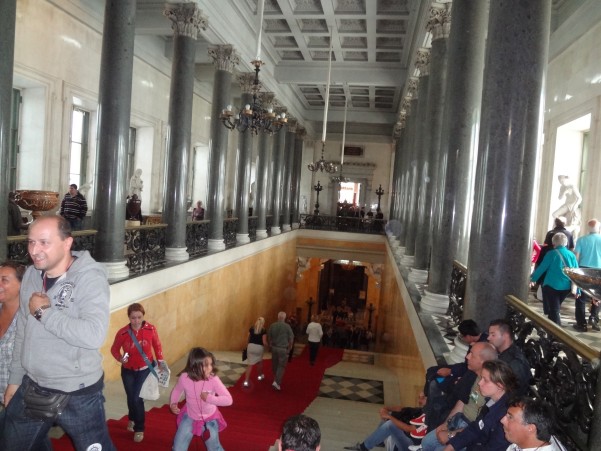 |
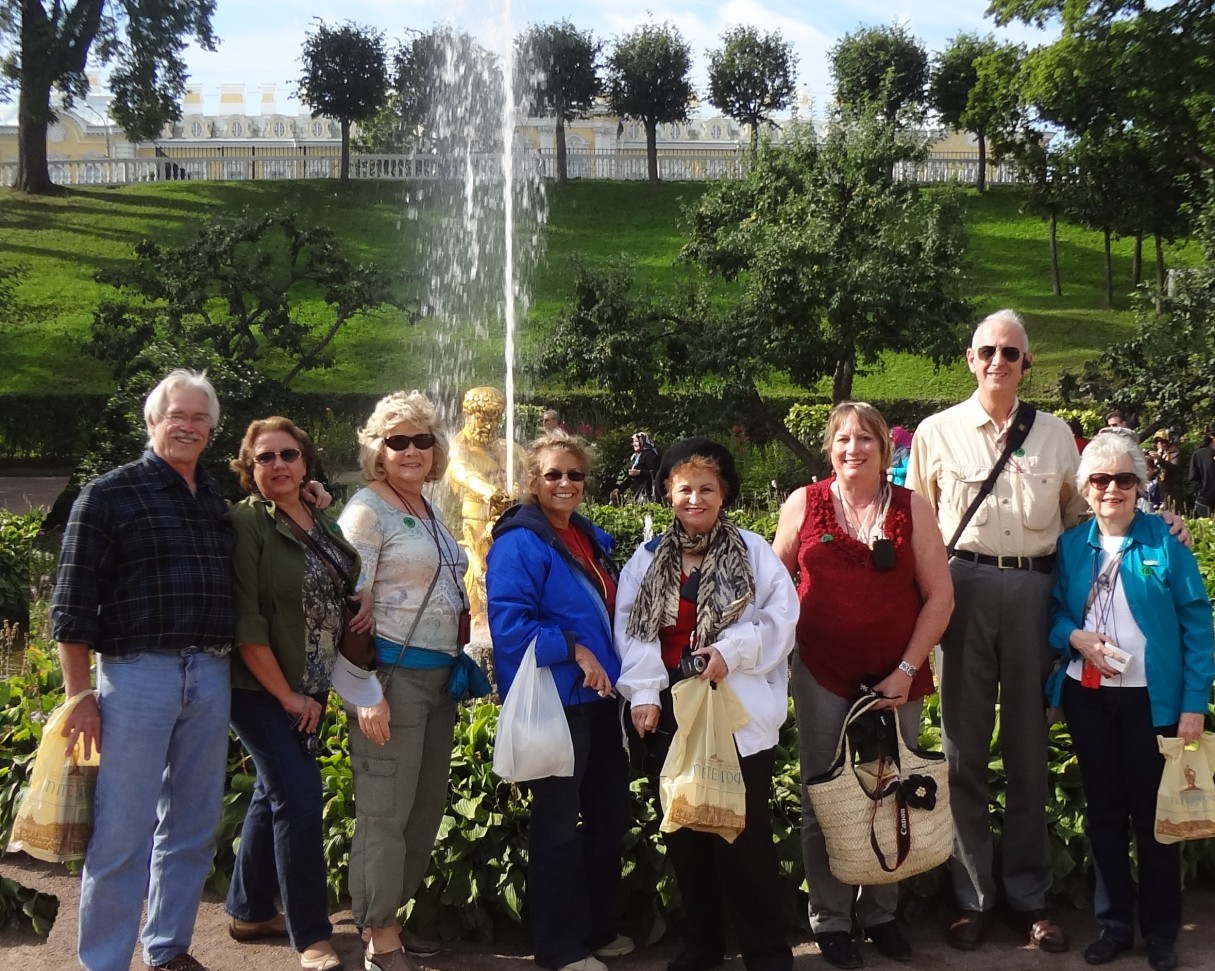
Here we have Rick, Marsha, Sandra, Marla,
Velma, Susan, Jess, Pat. I am holding onto Marsha so she
doesn't get lost while we are taking the picture.
|
Next Story:
Tallinn, Estonia
|
|